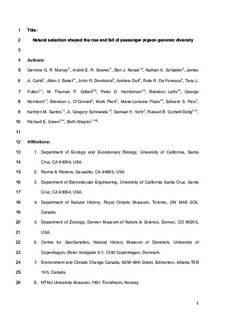Natural selection shaped the rise and fall of passenger pigeon genomic diversity
Murray, Gemma G.R.; Soares, André E.R.; Novak, Ben J.; Schaefer, Nathan K.; Cahill, James A.; Baker, Allan J.; Demboski, John R.; Doll, Andrew; Da Fonseca, Rute R.; Fulton, Tara L.; Gilbert, Marcus Thomas Pius; Heintzman, Peter D.; Letts, Brandon; McIntosh, George; O'Connell, Brendan L.; Peck, Mark; Pipes, Marie-Lorraine; Rice, Edward S.; Santos, Kathryn M.; Sohrweide, A. Gregory; Vohr, Samuel H.; Corbett-Detig, Russell B.; Green, Richard E.; Shapiro, Beth
Journal article, Peer reviewed
Accepted version
Permanent lenke
http://hdl.handle.net/11250/2480523Utgivelsesdato
2017Metadata
Vis full innførselSamlinger
- Institutt for naturhistorie [1213]
- Publikasjoner fra CRIStin - NTNU [37221]
Sammendrag
The extinct passenger pigeon was once the most abundant bird in North America, and possibly the world. Although theory predicts that large populations will be more genetically diverse, passenger pigeon genetic diversity was surprisingly low. To investigate this disconnect, we analyzed 41 mitochondrial and 4 nuclear genomes from passenger pigeons and 2 genomes from band-tailed pigeons, which are passenger pigeons’ closest living relatives. Passenger pigeons’ large population size appears to have allowed for faster adaptive evolution and removal of harmful mutations, driving a huge loss in their neutral genetic diversity. These results demonstrate the effect that selection can have on a vertebrate genome and contradict results that suggested that population instability contributed to this species’s surprisingly rapid extinction.
